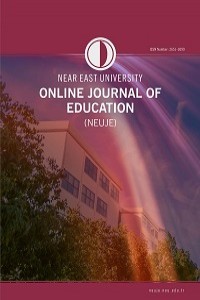EVALUATION OF THE TEACHING TECHNIQUES OF THE PIANO ARRANGEMENT OF AL YEMENI MOR YEMENI SONG
EVALUATION OF THE TEACHING TECHNIQUES OF THE PIANO ARRANGEMENT OF AL YEMENI MOR YEMENI SONG
___
- Baltaci, A. (2019). Nitel araştırma süreci: Nitel bir araştırma nasıl yapılır? Ahi Evran Üniversitesi Sosyal Bilimler Enstitüsü Dergisi, 5(2), 368-388.
- Direktör, C. (2018). Cyprus folk songs and aphrodite of cyprus kibris türküleri ile kibrisli afrodit. Public Relations Cultural & Media Studies, 325-338.
- Elmas, G., & Köse, H. S. (2012). Piyano eğitiminde müzikal terimler ve çalma tekniklerine ilişkin bilişsel düzey analizi. Fine Arts, 7(3), 246-257.
- Ertem, Ş. (2011). Orta düzey piyano eğitimi için repertuvar seçme ilkeleri. Kastamonu Eğitim Dergisi, 19(2), 645-652.
- Gedik, N., Altintas, E., & Kaya, H. (2018). Fen ve teknoloji dersinde verilen ev ödevleri hakkındaki öğrenci görüşleri. Journal of European Education, 1(1), 6-13.
- Gorgoretti, B. (2020). Milli kimliğin biçimlenmesinde müzik eğitiminin rolü. Anadolu Üniversitesi Eğitim Fakültesi Dergisi, 4(2), 143-162.
- Ilgar, M. Z., & Ilgar, S. C. (2013). Nitel bir araştırma deseni olarak gömülü teori (Temellendirilmiş Kuram). Available at https://88.255.218.197/xmlui/bitstream/handle/20.500.12436/111/Nitel%20Bir%20Ara%C5%9Ft%C4%B1rma%20Deseni%20Olarak%20G%C3%B6m%C3%BCl%C3%BC%20Teori? sequence=1&isAllowed=y .
- İlkay, G., & Sarı, A. (2020, September). Piyano pedagojisine yönelik öğretim yöntemlerinin geliştirilmesi. In Conference Proceeding Book (p. 28). Near East University.
- Jacobson, J. M., Lancaster, E. L., & Mendoza, A. (2015). Professional Piano Teaching, Volume 2: A Comprehensive Piano Pedagogy Textbook. Alfred Music.
- Kalkanoğlu, B. (2020). Başlangıç piyano öğretiminde nota okuma yaklaşımlarına ilişkin üç metot analizi örneği. Journal of Turkish Educational Sciences, 18(1), 17-28.
- Kanal Sim. (2018, Ocak 30). Kamran Aziz Belgeseli [Video]. Retrieved from https://www.youtube.com/watch?v=M2QddJNM1zc&t=725s&ab_channel=KanalSim
- Karataş, Z. (2015). Sosyal bilimlerde nitel araştirma yöntemleri. Manevi Temelli Sosyal Hizmet Araştırmaları Dergisi, 1(1), 62-80.
- Madanoğlu, N. (2019). Halk türkülerinin piyano düzenlemeleri bağlamında “piyano için 9 türkü” kitabının analizi. İstanbul Aydın Üniversitesi Güzel Sanatlar Fakültesi Dergisi, 5(10), 85-96.
- Özarslan, M. (2010) “Geleneksel Müzik ve Türküler Üzerine”, Türk Yurdu Dergisi Türkü Özel Sayısı, Ocak, S. 269, s. 53.
- Özdinçer, F. (2010). Türk halk oyunlarının geleceğe aktan imasında öğretimin önemi ve dört aşamalı öğretim süreci. Motif Akademi Halkbilimi Dergisi, 3(5), 120-132.
- Özgül, İ. (2017). Müzik öğretmenliği programi koro-1 dersi öğrencilerinin ölçü türlerine ilişkin giriş düzeyleri. Ahi Evran Üniversitesi Kırşehir Eğitim Fakültesi Dergisi, 18(2), 581-596.
- Özgür, Ü., & Aydoğan, S. (2009). Müziksel işitme okuma eğitimi ve kuram I. Ankara: Sözkesen Matbaası.
- Samson, J., & Demetriou, N. (2016). Music in Cyprus. USA: Routledge.
- Selçuk, H. (2020). Kıbrıslı Türklerde ilköğretim müzik eğitimi (1571-1983) (Unpublished master thesis). Yakın Doğu Üniversitesi Eğitim Bilimleri Enstitüsü, Müzik Eğitimi Anabilim Dalı, Lefkoşa.
- Taylor, E. R. (2014). The AB guide to music theory. Associated Board of the Royal Schools of Music.
- Vurana, F., Aksaygın, Ö., Uluöz, A., Keleş, M., Özakıncı, İ. (2020). Türkçe 8. Ankara. Available at http://talimterbiye.mebnet.net/Kitaplar/2020-2021/orta-lise/2020-2021/Ortaokul/Turkce8-2.pdf .
- Yondem, S. (2016). Geleneksel türk halk müziğindeki aksak ölçülerin okul şarkılarına yansıması. The Journal of Academic Social Science Studies, 7(48), 239-239.
- Winston, B. K. (2003). The development of a multimedia Web database for the selection of 20th century intermediate piano repertoire. The University of Texas at Austin.
- ISSN: 2651-3099
- Başlangıç: 2018
- Yayıncı: Yakın Doğu Üniversitesi
TEACHER'S OPINIONS ON THE EDUCATION OF INCLUSIVE STUDENTS
Mukaddes SAKALLI DEMİROK, Türkan GÖKALP
Şengül TÜMKAN, Mustafa ERİÇ, Fahri TÜMKAN
Roland NDUKONG TANGİRİ, Sanaria ABDULRAHMAN SADEEQ, Başak TİMUR DEMİRAL, Fatma MİRALAY
EVALUATION OF THE TEACHING TECHNIQUES OF THE PIANO ARRANGEMENT OF AL YEMENI MOR YEMENI SONG
Emine KIVANÇ ÖZTUĞ, Deniz AMCAZADE
THE PSYCHOLOGY OF TEACHERS AND STUDENTS DURING THE PANDEMIC PROCESS AND THE WAYS TO COPE WITH STRESS
THE VIEWS OF ADMINISTRATORS’ REGARDING THE USE OF TECHNOLOGY IN EDUCATION
Fatma KÖPRÜLÜ, Roland Ndukong TANGİRİ
GAMIFICATION IN COMPUTER SCIENCE COURSES: A LITERATURE REVIEW
Fezile ÖZDAMLI, Dlgash Faran YAZDEEN
CONTENT ANALYSIS OF CURRICULUM DEVELOPMENT RELATED STUDIES DURING: 2000 – 2019
